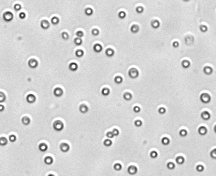Natural Killer (NK) Cells are large granular lymphocytes that belong to the innate immune system and make up approximately 10% of circulating lymphocytes. Unlike T cells, NK cells do not express CD3. NK cells are critical for protection from life-threatening infections and are important mediators of antitumor immunity. Rare reports of complete NK-cell deficiencies in humans have resulted in fatal infection during childhood. Uncontrolled or inappropriate NK cell response can lead to pathological conditions such as allograft rejection, graft vs. host disease, diabetes, aplastic anemia, and various autoimmune and neurological diseases.
There are two major groups of NK cells, distinguished by slight differences in surface marker expression. The majority of circulating human NK cells exhibit “dim” expression of CD56 and NKp46. Most of these NK cells can spontaneously lyse susceptible tumor cell targets via pore-forming perforin molecules and proteases (granzymes). Approximately 10% of circulating human NK cells and almost 100% of NK cells found in lymph nodes exhibit “bright” expression of CD56 and NKp46. These cells produce large amounts of cytokines and chemokines within minutes of activation, but have little ability to spontaneously kill target cells.
NK activation depends on a balance of activating and inhibiting signals that determine whether a target cell is susceptible to NK-mediated lysis. Several NK cell receptors recognize molecules that are not present on normal cells, but are induced during infection or carcinogenesis. Based on the cytotoxicity toward malignant cells, allotransplantation of NK cells has been used to treat hematologic diseases such as myeloid leukemia and pediatric acute lymphocytic leukemia. Cancer therapies being explored include agents that block NK cell inhibition or enhance the activation of NK cells. In addition, protocols for clinical-grade generation of active NK cells from CD34+ progenitor cells from cord blood are being tested and would enable the injection of highly-purifed, functionally-controlled NK cells to treat specific types of cancer.
ATCC Clone: NK-92
Adherent / Non-adherent: non-adherent
Cell Type: human lymphoblast
Cell Source: derived from PBMCs from a 50-year-old Caucasian male with malignant, non-Hodgkin’s lymphoma
Cell Characteristics: Form multicell aggregates. Cytotoxic to a wide range of malignant cells, including K562 cells.
Recommended Media: ATCC complete growth media. This cell line is dependent on the presence of high quality recombinant IL-2 at a minimum dose of 10 U/ml.
Concentration and viability of purified NK cells can be easily determined with the Cellometer T4, Cellometer Auto 2000, and Cellometer Vision Cell Counters. For NK cell concentration and viability in a mixed cell population, the Cellometer Vision CBA Image Cytometry System is recommended.
Natural Killer Cell References:
Romagne, F., et al. (2011). Natural Killer Cell-Based Therapies, F1000 Medicine Reports. 3(9). Doi: 10.3410/M3-9.
Caligiuri, Michael A. (2008). Human Natural Killer Cells, Blood. 112:461-469.
Anderson, Stephen K. (2005). Biology of Natural Killer Cells: What is the Relationship Between Natural Killer Cells and Cancer? Will an Increased Number and/or Function of Natural Killer Cells Result in Lower Cancer Incidence?, J. Nutr. 135:2910S.
Fregni, G., et al. (2011). Unique Functional Status of Natural Killer Cells in Metastatic Stage IV Melanoma Patients and Its Modulation by Chemotherapy. Clin. Cancer Res. 17: 2628-2637.
Spanholtz, J., et al. (2011). Clinical-Grade Generation of Active NK Cells from Cord Blood Hematopoietic Progenitor Cells for Immunotherapoy Using a Closed-System Culture Process. PLoS ONE. 6(6): e20740. Doi:10.1371/journal.pone.0020740.







Leave A Comment